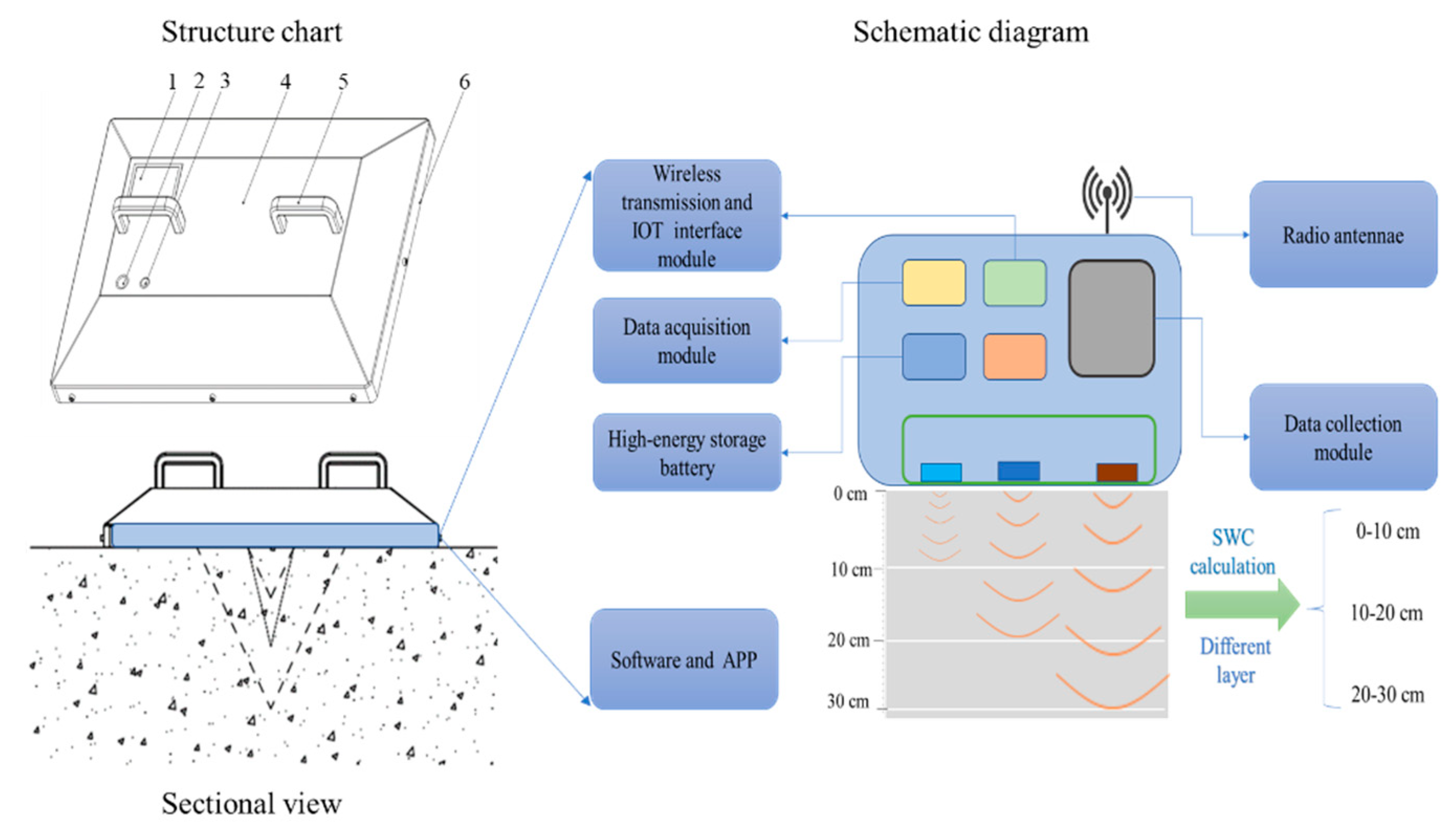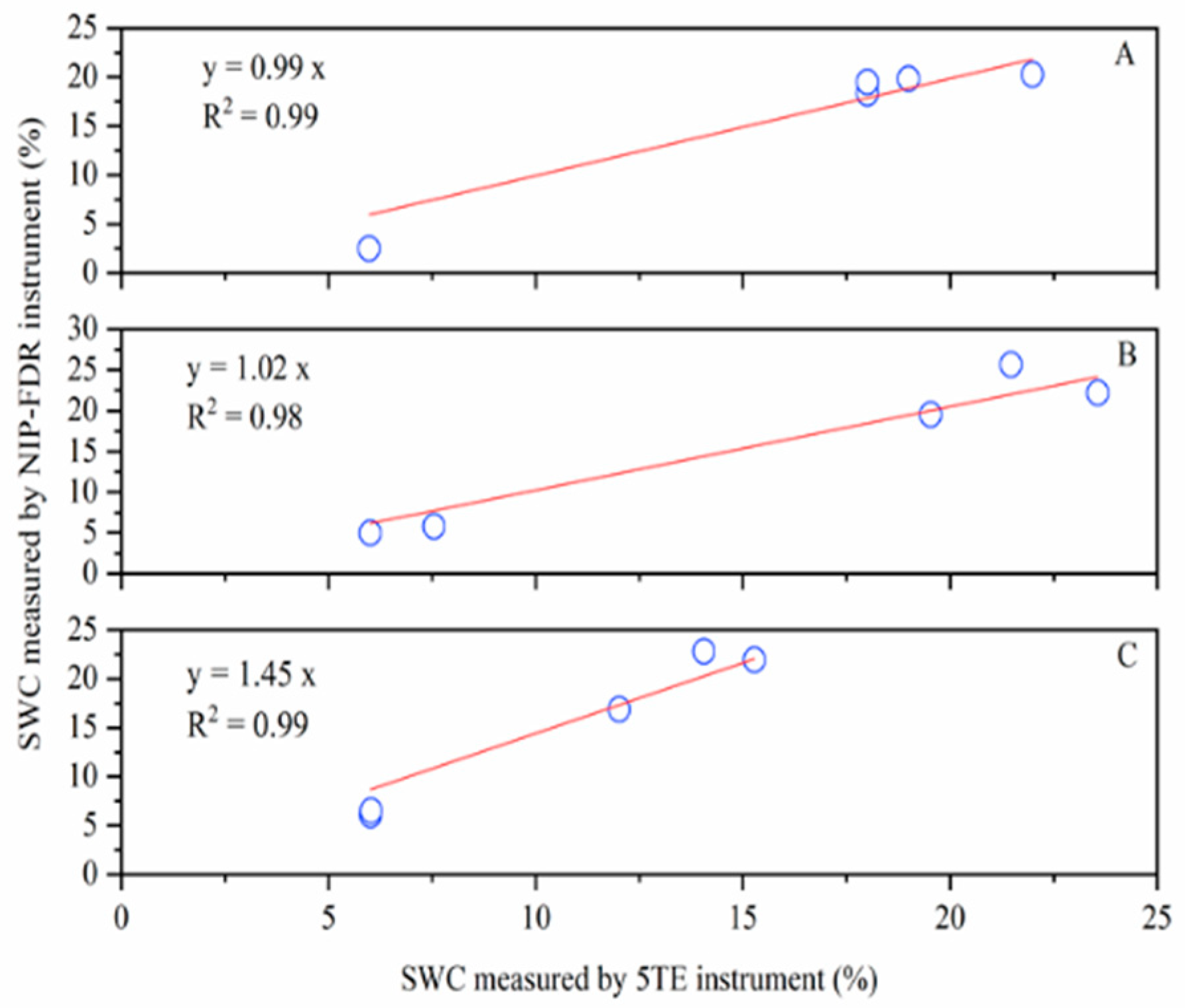A New Non-Inserted and Portable FDR Instrument for Measuring Surface Soil Water Content
Abstract
:1. Introduction
2. Materials and Methods
2.1. Instrument Design
- soil (volume) water content measurement range: 0—saturation.
- measurement accuracy: ±5%.
- measurement soil depth: 0–10, 10–20, 20–30 cm.
- stability time: 1 min.
- power supply mode: lithium iron phosphate battery (+3.3 V DC).
- working voltage: 3.3 V.
- average fault-free time: ≥100 h.
- operating temperature duration: −40–85 °C.
2.2. Instrument Operation Mechanism
2.3. Calibration and Verification Measurement
2.3.1. Indoor Calibration and Test
2.3.2. Field Measurement
3. Results
3.1. Indoor Test and Calibration
3.2. Field Measurement
4. Discussion
5. Conclusions
Author Contributions
Funding
Institutional Review Board Statement
Informed Consent Statement
Acknowledgments
Conflicts of Interest
References
- Kampf, S.K.; Tyler, S.W.; Ortiz, C.A.; Munoz, J.F.; Adkins, P.L. Evaporation and land surface energy budget at the Salar de Atacama, Northern Chile. J. Hydrol. 2005, 310, 236–252. [Google Scholar] [CrossRef]
- Hammami, Z.; Qureshi, A.S.; Sahli, A.; Gauffreteau, A.; Chamekh, Z.; Ben Azaiez, F.E.; Ayadi, S.; Trifa, Y. Modeling the effects of irrigation water salinity on growth, yield and water productivity of barley in three contrasted environments. Agronomy 2020, 10, 1459. [Google Scholar] [CrossRef]
- Jia, X.; Shao, M.A.; Wei, X.; Wang, Y. Hillslope scale temporal stability of soil water storage in diverse soil layers. J. Hydrol. 2013, 498, 254–264. [Google Scholar] [CrossRef]
- Kim, S.; Meki, M.N.; Kim, S.; Kiniry, J.R. Crop modeling application to improve irrigation efficiency in year-round vegetable production in the Texas winter garden region. Agronomy 2020, 10, 1525. [Google Scholar] [CrossRef]
- Guo, H.; Li, S.; Kang, S.; Du, T.; Tong, L.; Ding, R. Annual ecosystem respiration of maize was primarily driven by crop growth and soil water conditions. Agric. Ecosyst. Environ. 2019, 272, 254–265. [Google Scholar] [CrossRef]
- Sherrod, L.A.; Mcmaster, G.S.; Delgado, J.A.; Schipanski, M.E.; Fonte, S.J.; Montenieri, R.L.; Larson, K. Soil carbon pools in dryland agroecosystems as affected by several years of drought. J. Environ. Qual. 2018, 47, 766–773. [Google Scholar] [CrossRef] [Green Version]
- Shi, A.; Marschner, P. Drying and rewetting frequency influences cumulative respiration and its distribution over time in two soils with contrasting management. Soil Biol. Biochem. 2014, 72, 172–179. [Google Scholar] [CrossRef]
- Khanthavong, P.; Yabuta, S.; Asai, H.; Hossain, M.A.; Akagi, I.; Sakagami, J.-I. Root response to soil water status via interaction of crop genotype and environment. Agronomy 2021, 11, 708. [Google Scholar] [CrossRef]
- Vereecken, H.; Huisman, J.A.; Franssen HJ, H.; Brueggemann, N.; Bogena, H.R.; Kollet, S.; Javaux, M.; Van Der Kruk, J.; Vanderborght, J. Soil hydrology: Recent methodological advances, challenges, and perspectives. Water Resour. Res. 2015, 51, 2616–2633. [Google Scholar] [CrossRef]
- Fersch, B.; Francke, T.; Heistermann, M.; Schroen, M.; Doepper, V.; Jakobi, J.; Baroni, G.; Blume, T.; Bogena, H.; Budach, C.; et al. A dense network of cosmic-ray neutron sensors for soil moisture observation in a highly instrumented pre-Alpine headwater catchment in Germany. Earth Syst. Sci. Data 2020, 12, 2289–2309. [Google Scholar] [CrossRef]
- Du, K.; Qiao, Y.; Zhang, Q.; Li, F.; Li, Q.; Liu, S.; Tian, C. Modeling soil water content and crop-growth metrics in a wheat field in the North China plain using RZWQM2. Agronomy 2021, 11, 1245. [Google Scholar] [CrossRef]
- Egorov, Y.V.; Sudnitsyn, I.I.; Bobkov, A.V.; Kirichenko, A.V. Effect of the structure on the electrical properties of soils. Eurasian Soil Sci. 2013, 46, 284–290. [Google Scholar] [CrossRef]
- Fu, Y.; Lu, Y.; Heitman, J.; Ren, T. Root influences on soil bulk density measurements with thermo-time domain reflectometry. Geoderma 2021, 403, 115195. [Google Scholar] [CrossRef]
- Lukanu, G.; Savage, M.J. Calibration of a frequency-domain reflectometer for determining soil-water content in a clay loam soil. Water SA 2006, 32, 37–42. [Google Scholar]
- Zeng, J.; Li, Z.; Chen, Q.; Bi, H. Method for soil moisture and surface temperature estimation in the Tibetan Plateau Using spaceborne radiometer observations. IEEE Geosci. Remote Sens. Lett. 2015, 12, 97–101. [Google Scholar] [CrossRef]
- Robinson, D.A.; Campbell, C.S.; Hopmans, J.W.; Hornbuckle, B.K.; Jones, S.B.; Knight, R.; Ogden, F.; Selker, J.; Wendroth, O. Soil moisture measurement for ecological and hydrological watershed-scale observatories: A review. Vadose Zone J. 2008, 7, 358–389. [Google Scholar] [CrossRef] [Green Version]
- He, H.; Turner, N.C.; Aogu, K.; Dyck, M.; Feng, H.; Si, B.; Wang, J.; Lv, J. Time and frequency domain reflectometry for the measurement of tree stem water content: A review, evaluation, and future perspectives. Agric. For. Meteorol. 2021, 306, 108442. [Google Scholar] [CrossRef]
- Qin, A.; Ning, D.; Liu, Z.; Duan, A. Analysis of the accuracy of an FDR sensor in soil moisture measurement under laboratory and field conditions. J. Sens. 2021, 2021, 6665829. [Google Scholar] [CrossRef]
- De Oliveira, I.N.; De Souza, Z.M.; Lovera, L.H.; Farhate, C.V.V.; Lima, E.D.S.; Esteban, D.A.A.; Totti, M.C.V. Capacitance probe calibration for an Ultisol Udult cultivated with sugarcane by soil tillages. Agric. Water Manag. 2020, 241. [Google Scholar] [CrossRef]
- Sanches, A.C.; De Souza, D.P.; Ferreira De Jesus, F.L.; Mendonca, F.C.; Gomes, E.P.; Macedo Pezzopane, J.R. Comparison of water consumption estimates for tropical and winter forages by FDR probes and weighing lysimeters. Semin.-Cienc. Agrar. 2019, 40, 1115–1125. [Google Scholar] [CrossRef]
- Holthusen, D.; Pertile, P.; Awe, G.O.; Reichert, J.M. Soil density and oscillation frequency effects on viscoelasticity and shear resistance of subtropical Oxisols with varying clay content. Soil Tillage Res. 2020, 203, 104677. [Google Scholar] [CrossRef]
- Acosta-Motos, R.J.; Rothwell, S.A.; Massam, M.J.; Albacete, A.; Zhang, H.; Dodd, I.C. Alternate wetting and drying irrigation increases water and phosphorus use efficiency independent of substrate phosphorus status of vegetative rice plants. Plant Physiol. Biochem. 2020, 155, 914–926. [Google Scholar] [CrossRef]
- Kaluzewicz, A.; Bosiacki, M.; Spizewski, T. Influence of biostimulants on the content of macro- and micronutrients in broccoli plants exposed to drought stress. J. Elementol. 2018, 23, 287–297. [Google Scholar]
- Ozmen, S. Soil temperature activity on soil water content under organic and conventional managements in hazelnut or-chard. Fresenius Environ. Bull. 2016, 25, 3654–3665. [Google Scholar]
- Tu, C.; Li, F. Responses of greenhouse gas fluxes to experimental warming in wheat season under conventional tillage and no-tillage fields. J. Environ. Sci. 2017, 54, 314–327. [Google Scholar] [CrossRef]
- Zhao, X.; Li, F.; Ai, Z.; Li, J.; Gu, C. Stable isotope evidences for identifying crop water uptake in a typical winter wheat-summer maize rotation field in the North China Plain. Sci. Total Environ. 2018, 618, 121–131. [Google Scholar] [CrossRef]
- Du, K.; Li, F.; Leng, P.; Li, Z.; Tian, C.; Qiao, Y.; Li, Z. Differential influence of no-tillage and precipitation pulses on soil heterotrophic and autotrophic respiration of summer maize in the North China plain. Agronomy 2020, 10, 2004. [Google Scholar] [CrossRef]
- Du, K.; Li, F.; Qiao, Y.; Leng, P.; Li, Z.; Ge, J.; Yang, G. Influence of no-tillage and precipitation pulse on continuous soil respiration of summer maize affected by soil water in the North China Plain. Sci. Total Environ. 2021, 766, 144384. [Google Scholar] [CrossRef] [PubMed]
- Qin, A.; Ning, D.; Liu, Z.; Sun, B.; Zhao, B.; Xiao, J.; Duan, A. Insentek sensor: An alternative to estimate daily crop evapotranspiration for maize plants. Water 2019, 11, 25. [Google Scholar] [CrossRef] [Green Version]
- Skierucha, W.; Wilczek, A. A FDR sensor for measuring complex soil dielectric permittivity in the 10-500 MHz frequency range. Sensors 2010, 10, 3314–3329. [Google Scholar] [CrossRef] [Green Version]




Publisher’s Note: MDPI stays neutral with regard to jurisdictional claims in published maps and institutional affiliations. |
© 2021 by the authors. Licensee MDPI, Basel, Switzerland. This article is an open access article distributed under the terms and conditions of the Creative Commons Attribution (CC BY) license (https://creativecommons.org/licenses/by/4.0/).
Share and Cite
Qiao, Y.; Zhang, Q.; Li, F.; Liu, S.; Li, Q.; Du, K.; Zhang, H.; Li, B. A New Non-Inserted and Portable FDR Instrument for Measuring Surface Soil Water Content. Water 2021, 13, 2712. https://doi.org/10.3390/w13192712
Qiao Y, Zhang Q, Li F, Liu S, Li Q, Du K, Zhang H, Li B. A New Non-Inserted and Portable FDR Instrument for Measuring Surface Soil Water Content. Water. 2021; 13(19):2712. https://doi.org/10.3390/w13192712
Chicago/Turabian StyleQiao, Yunfeng, Qiuying Zhang, Fadong Li, Shanbao Liu, Qi Li, Kun Du, Hao Zhang, and Bo Li. 2021. "A New Non-Inserted and Portable FDR Instrument for Measuring Surface Soil Water Content" Water 13, no. 19: 2712. https://doi.org/10.3390/w13192712
APA StyleQiao, Y., Zhang, Q., Li, F., Liu, S., Li, Q., Du, K., Zhang, H., & Li, B. (2021). A New Non-Inserted and Portable FDR Instrument for Measuring Surface Soil Water Content. Water, 13(19), 2712. https://doi.org/10.3390/w13192712






